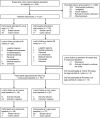Four-year effects of exercise on fatigue and physical activity in patients with cancer
- PMID: 29879968
- PMCID: PMC5992660
- DOI: 10.1186/s12916-018-1075-x
Four-year effects of exercise on fatigue and physical activity in patients with cancer
Abstract
Background: In the earlier randomized controlled Physical Activity during Cancer Treatment (PACT) study, we found beneficial effects of an 18-week supervised exercise program on fatigue in patients with newly diagnosed breast or colon cancer undergoing adjuvant treatment. The present study assessed long-term effects of the exercise program on levels of fatigue and physical activity 4 years after participation in the PACT study.
Methods: The original study was a two-armed, multicenter randomized controlled trial comparing an 18-week supervised exercise program to usual care among 204 breast cancer patients and 33 colon cancer patients undergoing adjuvant treatment. Of the 237 PACT participants, 197 participants were eligible and approached to participate in the 4-year post-baseline measurements, and 128 patients responded. We assessed fatigue and physical activity levels at 4 years post-baseline and compared this to levels at baseline, post-intervention (18 weeks post-baseline), and at 36 weeks post-baseline.
Results: Intention-to-treat mixed linear effects model analyses showed that cancer patients in the intervention group reported significantly higher moderate-to-vigorous total physical activity levels (141.46 min/week (95% confidence interval (CI) 1.31, 281.61, effect size (ES) = 0.22) after 4 years compared to the usual care group. Furthermore, cancer patients in the intervention group tended to experience less physical fatigue at 4 years post-baseline compared to the usual care group (- 1.13, 95% CI -2.45, 0.20, ES = 0.22), although the result was not statistically significant.
Conclusion: Patients with breast or colon cancer who participated in the 18-week exercise intervention showed significant higher levels of moderate-to-vigorous total physical activity levels and a tendency towards lower physical fatigue levels 4 years post-baseline. Our result indicate that exercising during chemotherapy is a promising strategy for minimizing treatment-related side effects, both short and long term.
Trial registration: Current Controlled Trials ISRCTN43801571 , Dutch Trial Register NTR2138 . Trial registered on 9 December 2009.
Keywords: Cancer; Chemotherapy; Exercise intervention; Fatigue; Long-term effects; Physical activity.
Conflict of interest statement
Ethics approval and consent to participate
The study was approved by the Medical Ethics Committee of the University Medical Center Utrecht and the local ethical boards of the participating hospitals (i.e., St. Antonius Hospital, Nieuwegein; Diakonessenhuis Hospital, Utrecht; Meander Medical Centre, Amersfoort; Rivierenland Hospital, Tiel; Orbis Medical Center, Sittard; Zuwe Hofpoort Hospital, Woerden). All participants signed informed consent.
Competing interests
The authors declare that they have no competing interests.
Publisher’s Note
Springer Nature remains neutral with regard to jurisdictional claims in published maps and institutional affiliations.
Figures


Similar articles
-
Socio-ecological correlates of physical activity in breast and colon cancer survivors 4 years after participation in a randomized controlled exercise trial (PACT study).PLoS One. 2020 Apr 16;15(4):e0231663. doi: 10.1371/journal.pone.0231663. eCollection 2020. PLoS One. 2020. PMID: 32298326 Free PMC article. Clinical Trial.
-
Effects of an 18-week exercise programme started early during breast cancer treatment: a randomised controlled trial.BMC Med. 2015 Jun 8;13:121. doi: 10.1186/s12916-015-0362-z. BMC Med. 2015. PMID: 26050790 Free PMC article. Clinical Trial.
-
Effects of an Exercise Program in Colon Cancer Patients undergoing Chemotherapy.Med Sci Sports Exerc. 2016 May;48(5):767-75. doi: 10.1249/MSS.0000000000000855. Med Sci Sports Exerc. 2016. PMID: 26694846 Clinical Trial.
-
Effects of physical exercise during adjuvant breast cancer treatment on physical and psychosocial dimensions of cancer-related fatigue: A meta-analysis.Maturitas. 2016 Mar;85:104-11. doi: 10.1016/j.maturitas.2015.12.007. Epub 2015 Dec 28. Maturitas. 2016. PMID: 26857888 Review.
-
Physical activity intervention benefits persist months post-intervention: randomized trial in breast cancer survivors.J Cancer Surviv. 2023 Dec;17(6):1834-1846. doi: 10.1007/s11764-022-01329-2. Epub 2023 Feb 1. J Cancer Surviv. 2023. PMID: 36723801 Review.
Cited by
-
Association between physical activity and health-related quality of life: time to deterioration model analysis in lung adenocarcinoma.J Cancer Surviv. 2023 Dec;17(6):1769-1779. doi: 10.1007/s11764-022-01259-z. Epub 2022 Oct 4. J Cancer Surviv. 2023. PMID: 36192668 Free PMC article.
-
Feasibility of a tailored home-based exercise intervention during neoadjuvant chemotherapy in breast cancer patients.BMC Sports Sci Med Rehabil. 2022 Feb 25;14(1):31. doi: 10.1186/s13102-022-00420-6. BMC Sports Sci Med Rehabil. 2022. PMID: 35216638 Free PMC article.
-
Long-term effects of exercise interventions on physical activity in breast cancer patients: a systematic review and meta-analysis of randomized controlled trials.Support Care Cancer. 2023 Jan 24;31(2):130. doi: 10.1007/s00520-022-07485-6. Support Care Cancer. 2023. PMID: 36692626 Free PMC article.
-
Effects of exercise during chemotherapy for breast cancer on long-term cardiovascular toxicity.Open Heart. 2023 Oct;10(2):e002464. doi: 10.1136/openhrt-2023-002464. Open Heart. 2023. PMID: 37903570 Free PMC article.
-
Supportive Care Needs of Newly Diagnosed Cancer Patients in a Comprehensive Cancer Center: Identifying Care Profiles and Future Perspectives.Cancers (Basel). 2024 Feb 29;16(5):1017. doi: 10.3390/cancers16051017. Cancers (Basel). 2024. PMID: 38473376 Free PMC article.
References
-
- Cleeland CS, Zhao F, Chang VT, Sloan JA, O’Mara AM, Gilman PB, et al. The symptom burden of cancer: evidence for a core set of cancer-related and treatment-related symptoms from the Eastern Cooperative Oncology Group Symptom Outcomes and Practice Patterns study. Cancer. 2013;119(24):4333–4340. doi: 10.1002/cncr.28376. - DOI - PMC - PubMed
Publication types
MeSH terms
Grants and funding
LinkOut - more resources
Full Text Sources
Other Literature Sources
Medical
Miscellaneous

